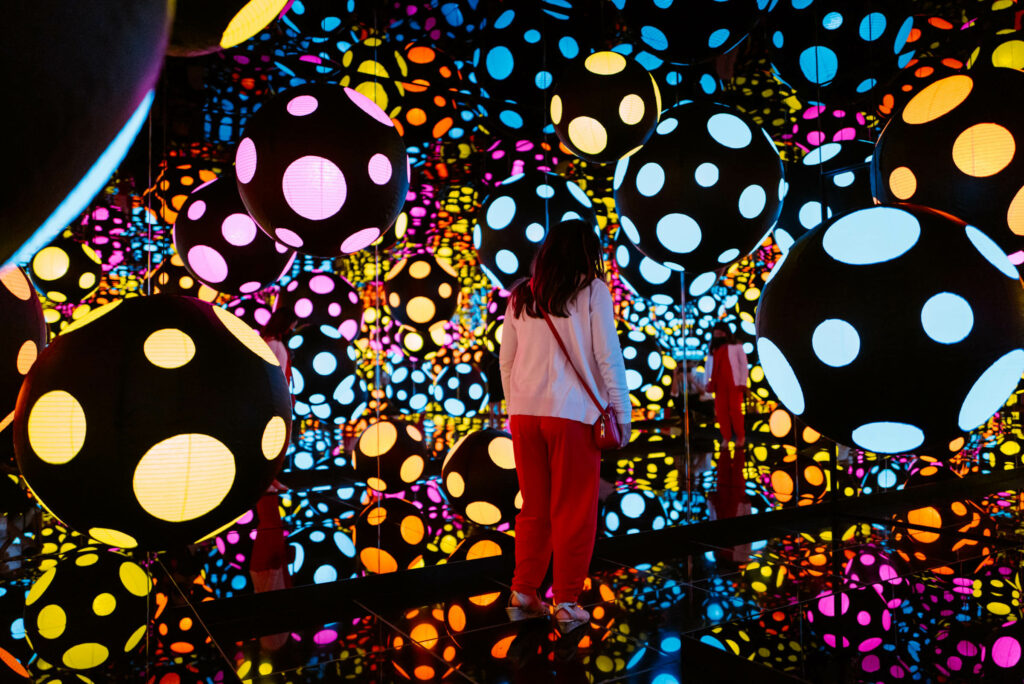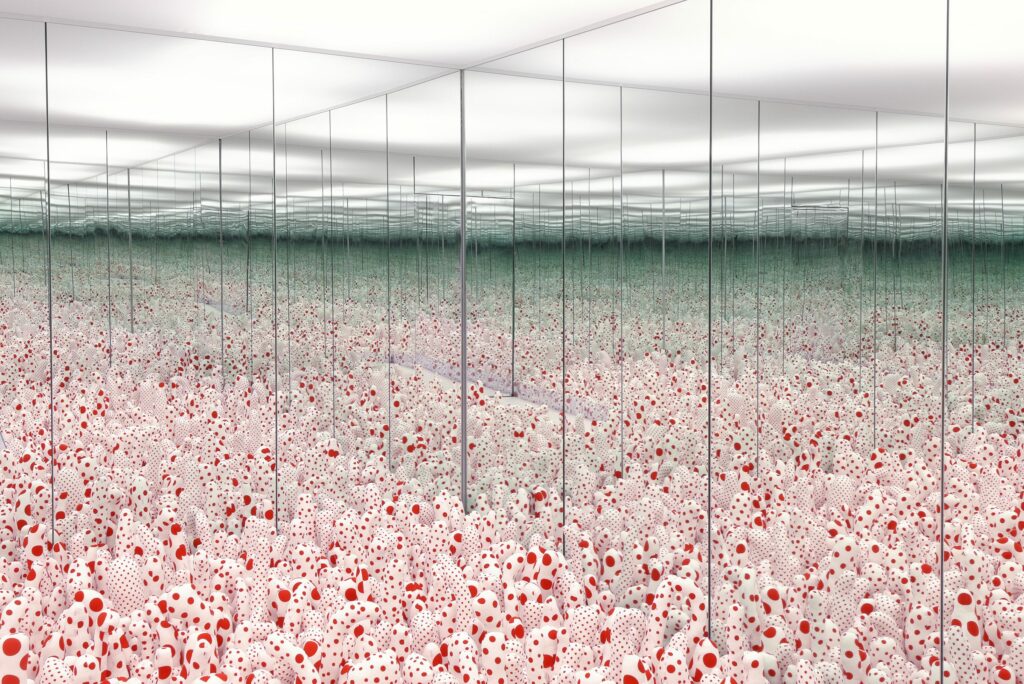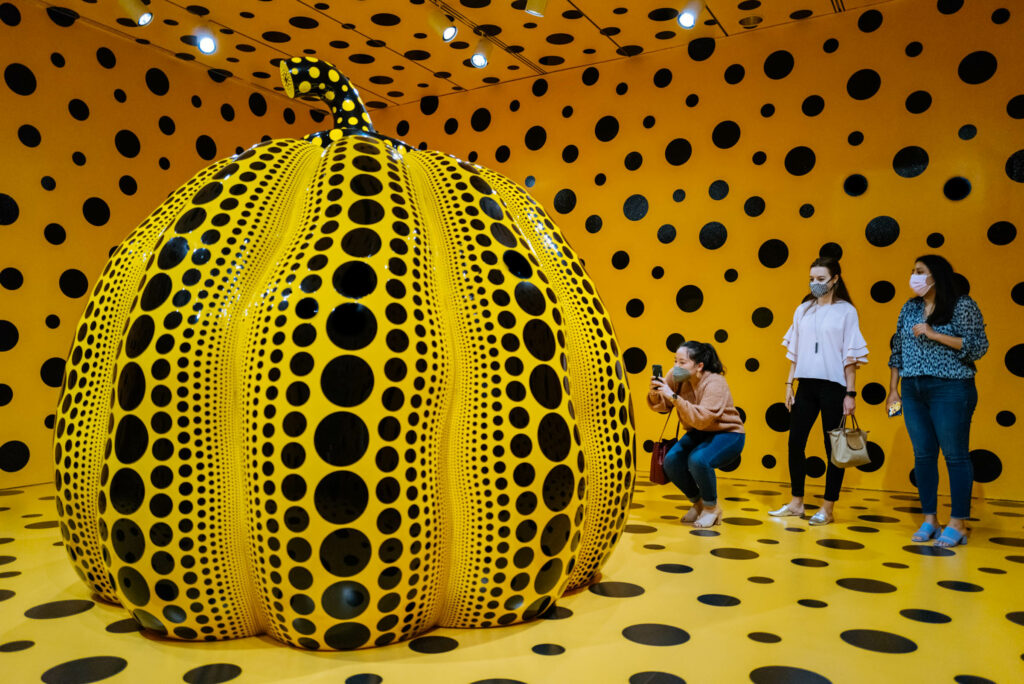An exhibition of work by the prolific contemporary Japanese artist Yayoi Kusama beckons viewers to connect the dots for an immersive experience of the infinite.
“One with Eternity,” on view through Nov. 27 at the Smithsonian’s Hirshhorn Museum in Washington, D.C., features five pieces the 93-year-old “Queen of Polka Dots” created during almost seven decades of art making in Tokyo and New York City.
In an effort to “honor Kusama’s distinctive vision,” the exhibition “explores its development across media,” according to the museum’s website. New to the Hirshhorn’s permanent collection are “Phalli’s Field,” the artist’s first Infinity Mirror Room, and “My Heart is Dancing into the Universe,” one of her most recent, as well as the sculpture, “Pumpkin.”
The Hirshhorn also owns the sculptural “Flowers-Overcoat” (1964) and a work on paper, “The Hill” (1953).
The title “One with Eternity,” explained Kate Gibbs, the Hirshhorn’s director of communications and marketing, “references the artist’s lifelong invitation through her artwork to, as she shared in the 1960s, ‘Forget yourself. Become one with eternity. Become part of your environment.’”

A 2017 exhibition, “Yayoi Kusama: Infinity Mirrors,” “introduced the Hirshhorn’s audience to the artist and her extraordinary output. It was a blockbuster here on the National Mall and at each of the five stops on its national tour. That year, the Hirshhorn welcomed 1.2 million visitors to our campus, an all-time record,” Gibbs recalled.
The Hirshorn’s mission is “to introduce the art, artists, and ideas of our time to the largest possible audience,” Gibbs said.
The Hirshhorn was the first museum to place Kusama’s Infinity Mirror Rooms at the center of her practice.
“Through endless iterations of our own image [in the mirrors] and her signature polka dots, Kusama fuses views of the microscopic and the macro. She asks us to see ourselves through her eyes and our own simultaneously, underlining our interconnectedness,” Gibbs said.
In each of the exhibit’s two Infinity Mirror Rooms, mirrors transform sculptural panels into a seemingly endless field, enabling the artist to come closer to representing infinity. These immersive installations “transform the intense repetition of [Kusama’s] earlier paintings and works on paper into a perceptual and participatory experience,” the Hirshhorn website states.
“All exhibition guests are invited to step into ‘Phalli’s Field,’ [the Infinity Mirror Room that debuted in 1965 and was remade in 2017] and walk a 4-foot ‘runway’ inside this field of tubers covered in Kusama’s signature polka dots,” Gibbs said. “Per the artist’s recommendation, museum-goers are invited inside this artwork for 30 seconds, not more than two at one time.”

Guests walk the path in the second Infinity Mirror Room, “My Heart is Dancing into the Universe” (2018), for 30 seconds, no more than four at a time.
“The room contains paper lanterns of different shapes, covered with black paper that reveals polka dots that change color in an endless sequence,” Gibbs said. “The walls, ceiling and floor are lined with black mirrors to reveal – in the lights of the lanterns — endless repeating patterns of dots with the visitors at the center echoing outwards in endless repetitions.”
An eight-foot-tall “Pumpkin” (2016), the third of the museum’s recently acquired works, is made of fiberglass-reinforced polyester with acrylic enamel coating. Repeating patterns of variously sized black dots adorn the bright-yellow sculpture. The artist has attributed her lifelong interest in pumpkins, which she said have “generous unpretentiousness,” to childhood seed harvesting with her grandfather.

“The impact of these five works … shows the through-line of the artist’s focus. There’s a span of 65 years between the early work on paper, ‘The Hill’ and ‘My Heart is Dancing’ but her interest in the power of repetition and scale to fill one’s field of vision remains true,” Gibbs said.
Why should East Coast audiences travel to see this exhibition? “Not only because Kusama is arguably the most beloved and famous living woman artist, but also for the opportunity to experience, with the Hirshhorn’s radically accessible fashion, the joy of experiencing the wonder and empathy that her biography and artwork transmits,” Gibbs said.
We could all use more joy and Yayoi Kusama delivers it without end.Admission to the exhibit at the Smithsonian’s Hirshhorn Museum and Sculpture Garden, Independence Avenue and 7th Street, Washington, D.C., is free. Passes are distributed on the Hirshhorn’s plaza Tuesday through Sunday beginning at 9:30 a.m., until all the day’s passes have been claimed.
by Ellyn Wexler
